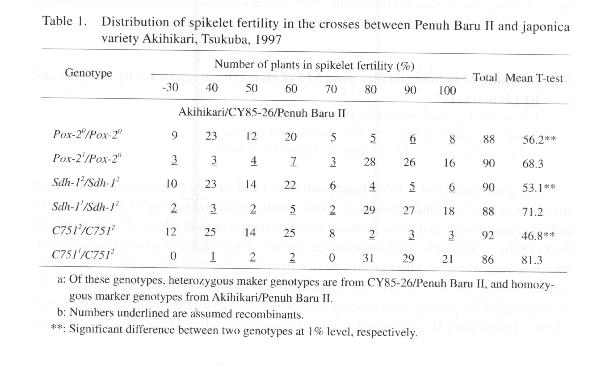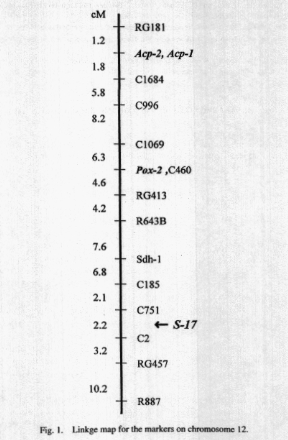J. WAN1, H. IKEHASIH2, M. Sakai1,
H. Horisue1 and T. IMBE’
1) National Agriculture Research Center, Tsukuba,
305-8666 Japan
2) Faculty of Agriculture, Kyoto University, Kyoto,
606-01 Japan
The semi-sterility of F1 hybrids between indica and
japonica varieties of rice has been attributed to an allelic interaction
at S5 locus, where indica and japonica varieties have S5’ and S5’, respectively,
and some javanica varieties have a neutral allele, S5”. (Ikehashi and Araki
1986). Through varietal screening, a series of new loci for causing female
gamete abortion were found, in other groups of rice hybrids. Similar allelic
interactions were found at loci S7, S8,S9, S15 and Si6 respectively, on
chromosomes 4,6,7, 12 and 1. All of them causes the sterility independent
of each other (Wan and Ikehashi 1995, Wan et a!. 1996). Penuh Barn II is
identified as one of javanica varieties which show hybrid steril
ity in crosses tojaponicas (Ikehashi and Araki 1987). The
locus for the sterility between Penuh Baru II and japonica was identified
as Si 7 by isozyme markers (Wan and Ikehashi 1995). S17 causes female gamete
abortion.
In this report the locus Si7 for hybrid sterility
between Penuh Barn II and Japonicas, was deterniined with isozyme and RFLP
marker analyses.
F, population of a three way cross, Akihikari
I CY85-26 II Penuh Barn II, was used for genetic analyses and tested marker
genotypes. CY85-26 is a Chinese variety developed from a cross of Peidi
I C57, and is known to be a wide compatible variety (WCV). Akihikari is
a japonica tester variety. Penuh Baru II is a javanica variety from Indonesia.
Two F, populations, Akihikari I Penuh Baru II and Penuh Barn 11/ CY85-26
were used as check.
According to the method to analyze one-locus
allelic interaction which causes F, semi-sterility (Ikehashi and Araki
1986), a three-variety cross was studied to confirm the 1:1 segregation
of fertile versus semi-sterile plants as shown in Table 1. To determine
co-segregthon of isozymes or RFLP marker loci with spikelet fertility,
the F, population of the three-way cross were grown at National Agriculture
Research Center in 1997. The spikelet fertility was determined by counting
fertile and sterile spikelets on the upper half of 3-4 panicles for each
plant.
The F, population of AkihikarilCY85-26//Penuh
Barn II showed segregation for sterility (Table 1), and the level of spikelet
fertility was significantly correlated with marker loci, Pox, Sdh1, RG413
and C751of chromosome 12, indicating an allelic interaction at the Si7
locus. The F, hybrid of Akihikari/Penuh Barn II showed semi-sterility (40.3%).
But the F1 hybrid of Penuh Barn Il/ CY85-26 (WCV) showed normal fertility
(9 1.3%).
For mapping of isozyme and RFLP markers
Mapmaker/3.0 was used (Fig. 1). The
recombination values between Si 7 and the isozyme marker
loci Sdh1, Pox2, Acpl and Acp2, and 12 RFLP markers were calculated from
the progeny of Akihikari/CY85-26// Penuh Barn H. The assumed recombinants
are underlined in Table 1, and the recombination frequencies are shown
in Fig. 1. Previously reported recombination frequencies between Sdh1 and
Pox2, between Sdhl and Acpi, and between Acpl and Pox2 were 16.6%, 35.6%
and 23.9%, respetively (Ishikawa et al. 1992, Causse et al. 1994). Thus,
the present estimates were in good agreement with those reported earlier.


References
Causse, M.A., T.M. Fulton, Y.G. Cho, S.N. Ahn, J. Chunwongse,
K. Wu, J. Xiao, Z. Yu, P.C. Ronald, S.E. Harrington, G. second, S.R. McCouch
and S.D. Tanksley, 1994. Saturated molecular map of the rice genome based
on an interspecific backcross population. Genetics 138: 1251-1274.
flcehashi, H. and H. Araki, 1986. Genetics ofF, sterility
in remote crosses of rice. In “Rice Genetics”, IRRI, P.O. Box 933, Manila,
Philippines, 119-130.
Ikehashi, H. and H. Araki, 1987. Screening and genetic analysis
of wide-compatibility in F1 hybrids of distant crosses in rice Oryza sari
va L. Tech. Bull. Trop. Agr. Res. Center, Japan, NO. 23
Ishikawa, R., T. Harada, M. Niizeki and K. Saito, 1992. Reconstniction
of linkage map with isozyme, morphological and physiological markers in
rice chromosome 12. Japan. J. Breed. 42: 235-244.
Wan, J., Y. Yamaguchi., H. Kato and H. Ikehashi, 1996. Two
new loci for hybrid sterility in cultivated rice (Oryza sariva L.). Theor.
Appi. Genet. 92: 183-190.
Wan, J. and H. Ikehashi 1995. Identification of a new locus
5-16 causing hybrid sterility innative rice varieties (Oryza sativa L.)
from Tai-hu Lake region and Yunnan province, China. Breeding Science 45:
461-
470.
Wan, J. and H. Ikehashi, 1995. A new locus for hybrid sterility
in remote crosses of cultivated rice (Oryza sati va L.). (S-IT). Breeding
Science 45: (Suppl. 2)191.

